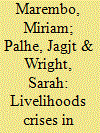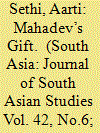| Srl | Item |
| 1 |
ID:
154558


|
|
|
|
|
| Summary/Abstract |
The Vidarbha region in Maharashtra, India, home to 3.4 million smallholder farmers, is a major cotton-producing region in one of the wealthiest Indian states. However, between 1995 and 2013, more than 60,000 farmers took their own lives. Many of these suicides have been linked to extreme debt created by the expensive mono-cropping of Bt cotton. Some farming households have responded to these pressures by abandoning Bt cotton growing and turning to sustainable agriculture using traditional mixed-cropping methods. Yet the question remains: have the changes produced better livelihoods in Vidarbha? Using a food sovereignty framework, we assess the impact of these changes through an analysis of a 200-household survey across six districts in Vidarbha. We also explore the meaning of food sovereignty for those who practise it, seeking to better understand some of the complexities and experiences associated with the term.
|
|
|
|
|
|
|
|
|
|
|
|
|
|
|
|
| 2 |
ID:
170002


|
|
|
|
|
| Summary/Abstract |
In October 2016, protests erupted across southern India opposing a Supreme Court judgement banning an annual agricultural festival featuring jousts between men and bulls. The Court ruled the contests as infringing animal rights. Rural constituencies rallied behind the festival as a customary practice and symbol of agrarian culture. This essay suggests that the conflict between the two constituencies turns on whether animals are legal subjects or social persons. I analyse this festival-complex in Maharashtra to show that the ritual imagines animals not as rights-bearing species, but as members of the agricultural community. The rite does not disavow violence, rather it embeds its symbolisation within familial and productive relations between people and bullocks.
|
|
|
|
|
|
|
|
|
|
|
|
|
|
|
|